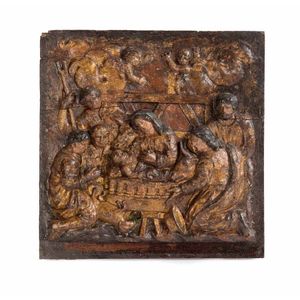Meiji Period Japanese Warrior Scroll Weights
You must be a subscriber, and be logged in to view price and dealer details.
Subscribe Now to view actual auction price for this item
When you subscribe, you have the option of setting the currency in which to display prices to $Au, $US, $NZ or Stg.
- Verso - Verso is the "back" side of a sheet of paper, art work, coin or medal. The front side is "recto".
- Bronze - An alloy of copper and tin, traditionally in the proportions of about 9 parts of copper to 1 part of tin.
The discovery of bronze in Western Asia in the 4th century enabled people to create metal objects which were superior to those previoulsy possible because of its strength and hardness, and it has been used throughout the world for weapons, coins, tools, statuary and other decorative items.
It is very fluid in a molten state, and its hardness, strength when set, and non-corrosive properties makes it most suitable for casting sculpture. - Shakudo - Japanese shakudo is a traditional alloy that has been used in Japan for centuries. It is primarily composed of copper and gold, with the copper serving as the base metal and the gold adding a yellowish hue to the alloy. Shakudo is known for its beautiful dark blue-black or black colour, which is achieved through the addition of a small amount of a patina-inducing element like silver or arsenic.
The word "shakudo" itself can be translated as "red copper" in Japanese, referring to the reddish-brown color of the pure copper base metal before it is patinated. The gold content in shakudo is usually around 4-10%, but this can vary depending on the specific purpose or desired appearance.
Shakudo has been traditionally used in various forms of decorative arts and crafts in Japan. It is particularly associated with metalwork, including sword fittings (such as tsuba, menuki, and kashira), jewelry, and small ornamental objects. The alloy's dark color provides a striking contrast to other metals like silver or gold, making it ideal for intricate inlay work or as a background for other decorative elements.
This item has been included into following indexes:
Visually similar items

A relief carved oak panel of a female fertility figure, probably English, 14th/15th century. 50 cm high, 12 cm wide

Stuart Devlin christmas box of I Saw Three Ships, hallmarked London 1977, with original packaging, 188g, 7 x 4.5 cm

A carved and gilt polychrome wooden panel of the nativity scene, Northern European, probably 16th/17th century. 33 cm high, 32 cm wide

Bronze medal (plaque) by Vernon [#557] issued by the French Committee for the Glasgow Exhibition. Depicts Scotland welcoming France to Glasgow with the city skyline in the background. (68.7 mm; 110g.) Accompanied by a group of artist postcards by Henri Cas
